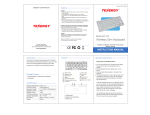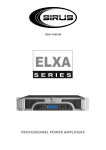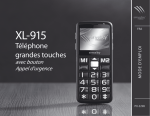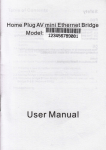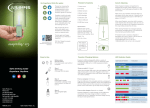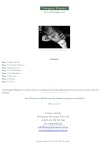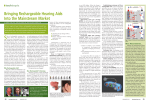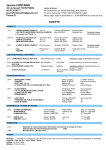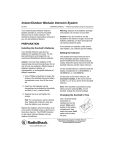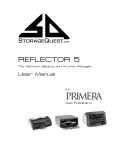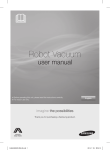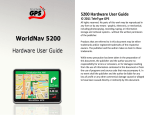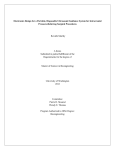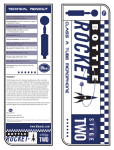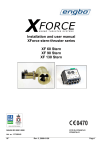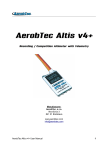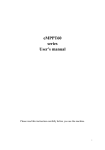Download File - Silas Van Natter
Transcript
Lithium Ion Batteries, a VAST Need to Know _Silas Van Natter Introduction Lithium ion batteries are the recommended batteries for VAST applications because they have a high energy to weight ratio (≈0.2Watt*hours/gram) and perform well in cold atmospheric conditions. Lithium ion batteries are high performing systems and like most high performing systems exist in a delicate balance. Changing this balance can be rewording, but upsetting this balance can be costly. This guide is intended to provide all the information necessary to safely and efficiently satisfy all the power requirements for high altitude ballooning. Basic Terms • • • C-rating: This is how much juice is in a lithium battery and is expressed in amp hours or milliamp hours (Ah or mAh). It is also common to talk about charging and discharging currents in C-terms. For example to charge a 1100 milliamp hour lithium ion battery at 0.5C would be to set the charger at 0.55 amps. S-specification: This is the count of how many battery cells are connected in series and is directly related to a battery pack’s voltage. A single lithium ion cell is nominally 3.7 volts (the actually range is 3 to 4.2 depending on the current level of charge). A 3S battery pack would therefor be 11.1 volts nominally with a max charge of 12.6 volts. P-specification: This is the parallel group count in a battery pack. Connecting battery cells in parallel combines the amp hours of each cell with out affecting the voltage. Take a standard lithium ion 18650 2200 mAh battery (18650 refers to 18 mm diameter 65.0 mm long). A 3S2P battery pack mad out of these cells have a total of 6 cells (two strings of three cells each) resulting in 4400 mAh at 11.1 nominal voltage. Destroying a Battery Destroying the chemistry in a lithium ion battery is as simple as letting the cell voltage or temperature become too high or low. Improper charging and over discharging are good ways to kill a lithium ion battery through voltage. An overly hot environment or excessive current flow are the best ways to overheat a battery. Excessive current flow takes on many forms but all result in generating heat that destroys the battery chemistry. Excessive current flow may be the result of charging the battery with too much power, attaching too great of an electrical load to the battery, shorting the contact leads, or even mechanically damage the battery in a way that allows the internally separated layers to come in contact. In the event that a lithium ion battery is damaged and needs to be completely neutralized it can be soaked in a sizable bucket of salt water. Proceed with caution if any of these lithium ion watch-out situations are encountered. • The voltage drops bellow 3.0 volts or rise above 4.20 volts • The battery is or will be discharged above at 2C (includes short-circuiting). • The battery is or will be charged above at 1C. • The battery temperature falls below -20°C or rises above 60°C. Basic Charging Lithium batteries are not subject to any charge memory and will suffer no ill effects from receiving fractional charges as long as the charging is done correctly. Lithium based batteries need to be charged in a very specific manor. This means that a special charger set on special settings is mandatory. Failure to correctly charge a lithium ion battery will end catastrophically. To charge the VAST standard battery (as seen in Figure 2, may be white or black) with a Thunder Power Digital Balancer and Charger/Discharger: 1. Connect the positive and negative charger input leads to a stable 12 volt power supply. 2. Connect the charger connector to the battery pack. 3. Hold down SEL MODE to enter and exit the charging mode menues. Press SEL MODE to go on to the next category. 4. Select: LiPo, 95% or 100% Charge, PLUS CHARGE OFF, CUT OFF 3.00V, TimeOut 10 MIN, EXTERNAL BALANCER, BEEPER ON or OFF, INPUT PWR 12.00V, SYSTEM TIMEOUT 5 Hour. 5. After exiting the charging mode menu and reentering the operational screen press the ENT/STOP button to move between categories and select 3s and C=0.8A. Hold down the ENT/STOP button to begin charging. If the charger detects something wrong it will beep, refuse to charge, and display possible miss-settings. When the charger tries to detect an external balancer hit INC to skip the process. The Charger will then go into a brief initial charge before continuing on with the main charging process. For more information see TP610C User’s Manual. Advanced Charging Safely charging a lithium ion battery is as simple as putting energy into it without violating any of the watch out situations as specified earlier. If any kind of custom charging is attempted the charging voltage must not exceed 4.2 volts and the charging current must not exceed 1 C. This is known as constant voltage current limiting charging. It is less stressful on a battery if a lower charging current is used. 0.5 C to 0.7 C is a commonly recommended charging current. A charging procedure (3 V to 4.2 V) starts with applying 4.2 volts to a cell at a current not to exceed a chosen safe level. Once the battery reaches 4.2 volts the current will start to taper as more energy saturates into the depths of the battery. The battery is fully charged when the current naturally slows to 0.1 C. If a lithium battery is below 3 volts a charging current of 0.1 C or less may be able to revive the battery back above the 3 volt minimum. If this battery rejuvenation is attempted the battery should not be left unattended and should be checked every few minutes to make sure that the voltage is increasing and the battery is not over heating. A properly charged lithium ion battery will not be overly warm to the touch. Unless specifically stated in a battery’s data sheet a battery needs to be kept within a 0°C to 45°C temperature range. Charging at a higher current does not decrease the total charge time. The battery will reach 4.2 volts faster but the saturation time will take longer. A full charging takes around 3 hours. If a battery is charged below 0.18 C the battery will be completely saturated by the time it reaches 4.2 V and a voltage reading can be used to indicate the end of charge. Figure 1 shows how a constant voltage current liming charger interacts with the chemistry of a lithium ion battery in a time dependent plot. Figure 1: This plot shows how voltage, current, and capacity as a function of time in a typical charging. The seemingly complex curves are mostly a product of battery chemistry and have less to do with the charger. One note not labeled on the plot is that the range for capacity (solid line) travels from 0% to 100%. (3) Over charging a lithium ion past 4.2 volts has been safley documented up to 4.35 volts. This will pack an extra 10% into a battery but will significantly affect the number of charge cycles a battery has as it degrads. VAST batterys are not typically exposed to high a cycle life so charging slightly above 4.2 volts would not notably affect the life of the battery. However an extra 10% capasity has never been necisarry for a VAST aplication and it is recommended to not excede a 4.2 volt charge. Figure 2 shows how over charging affects the cycle life. Figure 2: These lines show the capacity as the charge/discharge cycle count progresses for a set of charging voltages. This plot is for a 940 mAh cell but a percent capacity can be easily applied to other cell capacities. (3) Storage Lithium Ion batteries slowly degrade over time by about 20%/year. Degradation can be slowed to by storing batteries partially charged and at lower temperatures as seen in Table 1. Table 1: Estimated recoverable capacity for lithium Ion batteries based on storage conditions. (1) One important note if it is decided to store these batteries at a lower temperature. The fridge is the recommended cold store place for lithium ion batteries. It is not recommended to put these batteries in the freezer. There is no water to cause freezing damage in a lithium ion battery and the lithium is stable well below the temperature found in a common freezer so technically no harm will come to the battery. The reason freezer storage is not recommended is because condensation is prevalent in freezers (especially during a defrost cycle), and the moister can damage the batteries. If an experiment involving a lithium ion battery is preformed in a common freezer the battery should be sealed off from environmental moister. No special battery concerns apply to experiments run in the VAST cold chamber. The most important correlation demonstrated in Table 1 is the charge level that the batteries are stored at. To determine charge level a correlation published by Battery University is provided in Table 2 and Figure 3. Volts/cell 4.2 4.1 4 3.9 3.7 3 % Charge 100% 90% 70% 50% 40% 5% Table 2: Reference %Charge by Cell Voltage (2) Figure 3: %Charge by Cell Voltage (2) Buying a Lithium Ion Battery Lithium ion batteries can be bought in either cells or packs. Listed are a few good sources for standard consumer grade lithium ion batteries. • ebay.com • amazon.com • batteryspace.com • all-battery.com • orbtronic.com When purchasing a battery cell it is always desirable to find a data sheet. Packs are simply combinations of cells so a data sheet for a pack is whatever the seller lists plus the data sheet for the cells that make up the pack. Batteries in Cold Conditions The lower stratosphere hovers around -50°C and VAST has been sending consumer grade lithium ion and even alkali batteries through this for years with no failures ever attributed to a battery becoming too cold. It is possible that some failures should have been attributed to batteries becoming too cold, but the overwhelming majority of batteries have worked. The main reason under specified batteries have historically worked so well for VAST is that the temperature inside stays significantly warmer then the outside environment. This is due to the insulating properties of the capsule, the thermal mass of the system, and the heat generated by the circuitry. Figure 4 shows data collected during a previous VAST launch. Figure 4: Temperature and pressure verses time recorded during a previous VAST launch. Of notable interest for lithium ion batteries is that the internal temperature stays significantly higher then the external temperature. The internal temperature line shown here doesn’t fall below -10°C during the duration of the flight. This is good because at –10°C our lithium ion cells will still deliver 85% of their room temperature energy. All datasheets for the standard consumer grade lithium ion cells list -20°C as the minimum operating temperature, but chemically the lithium electrolytes don’t freeze until -40°C. This leaves up to an additional 20°C of pushing a battery to its limit. Operating in extreme cold caries a progressively heavy penalty though. The cost of operating in less then room temperature conditions is a significant decrease in available battery capacity and operating voltage. Figure 5 shows how the percent capacity decreases with temperature. Figure 5: This plot shows cell voltages during a constant current discharge. This is taken from the Tenergy 18650 datasheet. (1) At -20°C only 43% of the rated capacity is available. Thankfully a standard 18650 cell has about 6 times the mAh needed to power a Micro-Trak which means that a tracking module could be even colder then -20°C and still transmit the entire flight. Other methods to keep the temperature up implemented by VAST have included hand warmers to generate extra heat and taping seams in an effort to further decrease the heat transfer by eliminating airflow into the capsule. The effects of neither have been evaluated. Specialty Batteries If extreme battery demands are deemed necessary there are a variety of specialty lithium batteries on the market. These batteries have increased energy density, high current draw capacity, and/or an increased temperature operating rang. However these options come with tradeoffs. As a general rule the lithium triangle of specialty battery cells is capacity, operating temperatures, and rechargeability. Upgrading one side of the triangle comes at the expense of one of the others. Using specialty batteries also means researching and hunting for a battery, datasheet and supplier. Two examples of specialty batteries that could prove useful in the extreme conditions of near space are the Saft BA5800/U Battery and the Tadiran TLI 1550. The Saft BA5800/U is not a true lithium ion but rather a lithium sulfur dioxide battery with a nominal voltage of 6 V instead of 3.7V. However the over all energy density (Watt*hours/grams) is roughly equal to a lithium ion. This is a military grade battery and is designed to operate from -50°C to 70°C. The trade off is that lithium sulfur dioxide batteries are not rechargeable. These batteries are widely available from specialty battery sights and military suppliers for about $20 each. The Tadiran TLI 1550 is the rechargeable low temperature side of the triangle. These batteries are designed for remote wilderness monitoring stations and are designed to be charged and discharged at -40°C. The capacity tradeoff is that these batteries only hold about half the energy as the same size consumer grade lithium ion. These batteries also run $20 a piece but are only sold through EVS Supply (evssupply.com). Always check the rated current draw when considering a specialty battery. There are a lot of available batteries (especially non rechargeable) with exceptionally high capacitance that are designed for slower discharge rates. For example, the Saft LS 14500 is an economical non rechargeable high capacity lithium thionyl chloride battery rated to operate down to -60°C. The only problem is that these cells are only rated to put out 70mA of current. This is enough to power an Arduino bored with a few sensors or a GPS receiver, but not both. Experamentat power demands need to be known when References: 1) Terrace, Kato “TENERGY 18650 2200mAh Li-Ion Cell” Tenergy Corporation. 2009. < https://www.jameco.com/Jameco/Products/ProdDS/2144243.pdf> 2) Isidor, Buchmann. "How to Prolong Lithium-based Batteries” Battery University. October 2010. <http://batteryuniversity.com/learn/article/how_to_prolong_lithium_based_batteries> 3) “Charging Lithium-ion” November 2010. <http://batteryuniversity.com/learn/article/charging_lithium_ion_batteries> 4) Lund, Mark. “Lithium-ion Battery Charging Basics” PowerStream Technology. 2012. < www.powerstream.com/li.htm> 5) Lund, Mark. “How much voltage does it take to charge a lithium-ion battery?” PowerStream Technology. December 30, 2012. <www.powerstream.com/lithuim-ioncharge-voltage.htm> Dissection of a Tenergy 186500 11.1 Volt 1100 Milliamp Hour Lithium Ion Battery pack with Thermistor Figure 6: Standard battery used in VAST. Red is positive, black is negative, and weight is thermistor. Figure 7: Two shrink-wraps enclose the three cells. This battery back is identified with the manufactures name (Tenergy). The cells are 18mm in diameter and 65mm long, which puts them in the 18650 size class. A web search for Tenergy 18650 would be enough information to find the specific datasheet for these cells. Note, the Cell Connector provides an electrical connection and is included for manufacturing purposes only. It does not serve any other purpose. Figure 8: This balancing circuit keeps the individual cell voltages the same and is the reason external balancing mode is selected when charging these batteries. Some lithium ion batteries come with a built in thermistor to sense battery temperature. A thermistor is a type of resistor whose resistance varies detectably with temperature. If battery temperature is not an issue the white wire can be disregarded/cut. Figure 9: A more broken apart view of a VAST standard battery.










